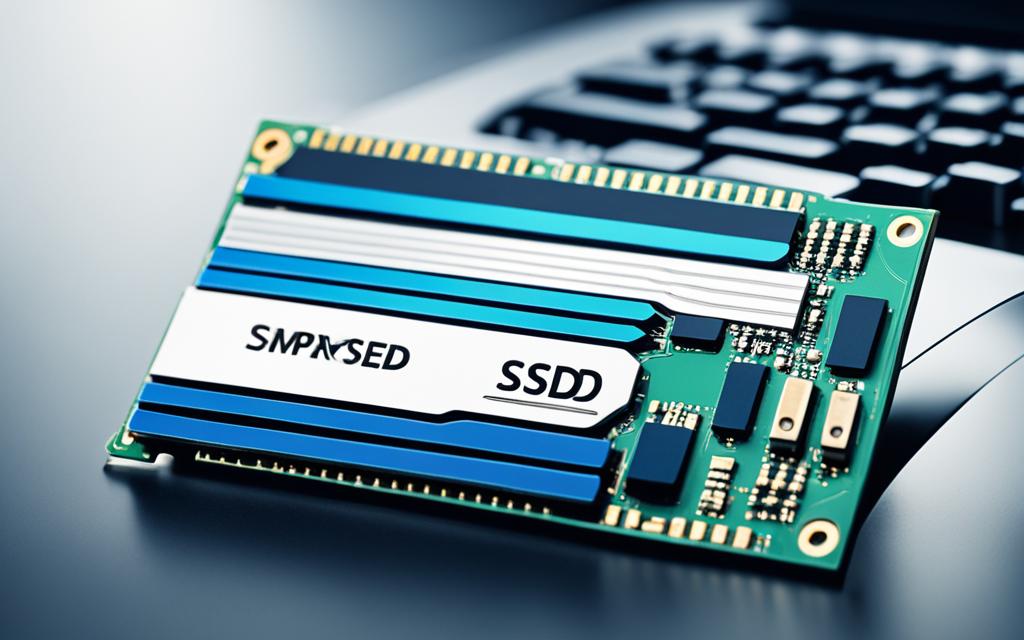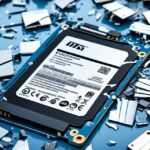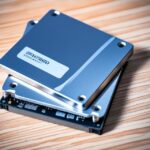Table of Contents
In the world of technology, SSD numbers are crucial. They help us understand the performance and traits of solid state drives. These figures show how compatible a drive is, how much it can hold, and what it’s best used for. They guide buyers, tech experts, and businesses in picking the right gear for their projects.
As data storage evolves, SSDs are getting more attention. Knowing these numbers can boost how well your digital tasks run. If you’re moving away from older hard drives or just improving your system, learning about SSD numbers is a smart move. Check out this detailed look at why SSD size matters: Understanding SSD Size1.
Key Takeaways
- SSD numbers are critical for assessing drive performance and compatibility.
- They aid in informed choices regarding solid state drives for diverse applications.
- Understanding SSD specifications can enhance data storage efficiency.
- Optimal SSD selection contributes to improved system performance and reliability.
- Recognising SSD form factors and interfaces is essential in the purchasing decision.
Introduction to SSDs and Their Importance
Solid state drive technology has drastically changed how we store data. SSDs use memory chips, making them faster and more reliable than hard disk drives (HDDs). They provide quick access to data and cut down on loading times for programs. Understanding the value of SSDs is essential as their use grows in various sectors.
SSDs don’t have moving parts, which makes them more durable and reliable. They are less likely to break down, unlike HDDs2. Their speedy performance makes them great for handling large amounts of data quickly2. With technology improving, SSDs are becoming more common in gaming and industrial areas3.
Solid state drives are not just about speed. They can move data at rates between 100-600 Mb/sec. NVMe SSDs even reach speeds over 3000 MB/s3. They’re also tough and use less power, making them perfect for devices like laptops and tablets4. This mix of speed and efficiency shows why SSDs are key in today’s computers.
| Feature | SSDs | HDDs |
|---|---|---|
| Speed | Fast data retrieval and lower load times | Slower load and access times |
| Durability | No moving parts, less prone to failure | Mechanical parts can wear out |
| Power Consumption | Lower, enhancing battery life | Higher, reducing battery efficiency |
| Use Case | Ideal for high-performance applications | Suitable for bulk storage needs |
What is an SSD Number?
An SSD number is a unique tag for solid state drives, telling us about important details. It’s crucial to understand this number to choose the right drive. This number shows what makes each SSD good or better for different uses.
Defining SSD Numbers and Specifications
SSD specs highlight key features like how much data they can hold, how fast they are, their shape, and how they connect to other devices. For example, sizes range from small 120GB drives to huge ones over 30TB. Speed can vary a lot, depending on if the SSD uses older SATA technology or the newer PCIe.
Key Factors Influencing SSD Numbers
When looking at SSDs, consider several things that affect how they work. The type of NAND technology matters a lot for speed, how long the SSD lasts, and its price. Also, the way it connects to your computer (SATA or PCIe) makes a big difference in speed. Then, its size matters for fitting it into your computer properly.
| NAND Type | Configuration | Performance | Longevity |
|---|---|---|---|
| SLC | Single Level Cell | High | Very High |
| MLC | Multi-Level Cell | Moderate | High |
| TLC | Triple Level Cell | Good | Moderate |
| QLC | Quad Level Cell | Lower | Low |
Types of SSD Form Factors
It’s key to know about SSD form factors when you’re picking your storage. Each type is different, shaped by what it can do and where it fits. This knowledge is essential for finding the right fit for your tech needs.
Exploring 2.5-inch and 3.5-inch SSDs
The 2.5-inch SSD is now the go-to size, perfect for most laptops and desktops. It’s chosen often for its easy fit and better speed. 3.5-inch SSDs, not as common, are used where lots of storage and speed are needed. These sizes work for many devices, making upgrading from old hard drives to SSDs a great choice for quicker and smoother operation6.
Knowing about these sizes helps folks understand their gear better. It’s all about making sure everything works together right7.
The Compact Nature of M.2 SSDs
M.2 SSDs have brought about smaller storage options. They’re as small as a gum stick, perfect for thin laptops and tablets. This suits today’s need for efficient SSD space use8. These drives come in various sizes and support different tech for speed and function. With this change, M.2 SSDs show the drive to meet varied storage wishes.
Understanding SSD Interfaces and Protocols
In the SSD world, knowing about different interfaces and protocols is key. Each interface affects how well an SSD performs. This is especially true when you look at the older SATA interface next to the newer PCIe interface and NVMe protocol.
The Role of SATA in SSD Connectivity
SATA is still quite common today, offering a steady connection for SSDs. SATA drives have transfer speeds of about 500-550 MB/s. This speed beats old hard drives but doesn’t match what newer technologies can do, like PCIe.
Benefits of PCIe and NVMe Technologies
PCIe marks a big step up in SSD tech, offering multiple data lanes for quicker CPU communication. With speeds up to 1GB/s, it quickly surpasses SATA’s capabilities. Then there’s NVMe, made just for SSDs to up efficiency, cut down on delay, and handle more commands. Together, they boost reading and writing speeds a lot, sometimes reaching 3500 MB/s, for better overall performance91011.
How SSD Capacity Affects Performance
SSD capacity is key to its performance. Modern SSDs use NAND flash memory, changing how we see speed and efficiency. A drive’s performance, including its speed and lifespan, depends on the NAND flash chips it has.
As SSD technology has progressed, capacity has seen a significant jump. Today, they range from a few gigabytes to several terabytes. This depends on the NAND chips and the data cells they have. For top speed and durability, SLC (Single-Level Cell) is best. But, options like QLC (Quad-Level Cell) offer more storage for less money, though they’re slower12. Thanks to 3D NAND tech, SSDs are now denser. This means faster speeds without needing more space12.
Impact of NAND Flash Memory Technology
SSDs come in sizes big and small, from gigabytes to terabytes and even petabytes in professional settings. The amount of NAND chips and their cell capacity influence this variety. Usually, drives offer 1 to 4 bits per cell. SLC gives the best performance and life. However, QLC increases storage at the cost of speed12. With 3D NAND technology, more memory can fit into the same space. This gives users more speed without needing a bigger drive12.
Capacity Considerations for Different Use Cases
What SSD capacity you need depends on how you use it. For simple tasks, like booting up the computer or light backups, 128GB might be enough. Yet, for heavy-duty jobs like video editing or intense gaming, more than 2TB might be needed13. It’s also wise to keep 10-15% of your SSD free. This helps keep your drive running well for longer13.
Different tasks require different SSD sizes. Knowing what you need helps pick the right SSD, ensuring it suits your needs perfectly.
Conclusion
Understanding SSD specs is crucial for those looking to improve their data storage. SSDs are much faster than traditional hard drives, boosting your productivity. They’re also tougher, keeping your data safe from physical harm14.
Exploring SSDs further, it’s clear how important it is to know about their designs and tech. This knowledge ensures you’re prepared for future data storage trends15. SSD technology is always getting better, focusing on speed and reliability, which changes how we handle data.
SSDs aren’t just about quick access or big storage space. It’s also key to understand their technical details, like how they manage wear. By putting effort into SSDs, we can revolutionise our data storage methods, making computing faster and more dependable16.
FAQ
What does an SSD number represent?
An SSD number is a unique code for solid state drives. It tells us about the drive’s capacity, speed, shape, and connection type. This helps people pick the right SSD for their needs.
Why are SSDs preferred over traditional hard drives?
SSDs are chosen for their speed, which leads to quicker start times, faster data access, and more reliability than old hard drives.
How does NAND flash memory affect SSD performance?
The kind of NAND flash memory in an SSD affects its speed, life span, and price. Higher-quality types offer better performance and last longer.
What are the common SSD form factors?
Commonly, SSDs come as 2.5-inch and 3.5-inch drives for standard drive slots. There are also M.2 drives for smaller spaces.
What role do interfaces play in SSD performance?
SSD interfaces like SATA, PCIe, and NVMe greatly influence speed. SATA is slower, whereas PCIe/NVMe allow for much faster data transfer.
How does SSD capacity influence its use?
The size of an SSD impacts how it performs; larger drives are faster and more durable. They’re better for heavy tasks like video editing or gaming.
What is the significance of SSD numbers in choosing the right drive?
Knowing SSD numbers helps choose the right drive. They show compatibility, size, and performance, aiding in smart buying decisions.
Can SSDs improve overall system responsiveness?
Yes, SSDs can make your system much snappier. They cut down on boot time and speed up app performance by fetching data quickly.
Source Links
- https://www.superssd.com/kb/understanding-ssd-specifications/ – Understanding SSD Specifications | SuperSSD
- https://www.techtarget.com/searchstorage/definition/SSD-solid-state-drive – What is an SSD (Solid-State Drive)?
- https://www.geeksforgeeks.org/introduction-to-solid-state-drive-ssd/ – Introduction to Solid-State Drive (SSD) – GeeksforGeeks
- https://www.avast.com/c-what-is-ssd – What Is a Solid-State Drive (SSD)?
- https://www.isbe.net/Documents/SSD_Coordinator_Handbook_Spring_2018.pdf – Microsoft Word – SSDC Implementation Handbook_WithSAAs_v4ISBE.docx
- https://www.crucial.in/articles/about-ssd/ssd-form-factors – SSD Form Factors
- https://www.kingston.com/en/blog/pc-performance/ssd-form-factors – Types of SSD Form Factors- Kingston Technology
- https://www.snia.org/forums/cmsi/knowledge/formfactors – SSD Form Factors | SNIA
- https://www.axiomupgrades.com/spotlight-detail/Understanding-SSD-specifications/ – Axiom | The OEM Alternative
- https://mattfife.com/?p=4309 – Understanding SSD form factors and interfaces
- https://centralvalleycomputerparts.com/articles/ssds-explained/ – SSDs Explained! A Basic Guide to Understanding SSDs
- https://www.techtarget.com/searchstorage/definition/solid-state-drive-SSD-capacity – What is solid-state drive (SSD) capacity?
- https://forum.level1techs.com/t/ssd-close-to-max-capacity-bad/139793 – SSD close to max capacity bad?
- https://uwaterloo.ca/arts-computing-newsletter/winter-2018/feature/everything-you-need-know-about-solid-state-drives-ssd – Everything you need to know about solid-state drives (SSD) | Arts Computing Office Newsletter
- https://www.compuram.de/blog/en/the-life-span-of-a-ssd-how-long-does-it-last-and-what-can-be-done-to-take-care/ – The life span of an SSD – how long does it last and what can be done to take care?
- https://www.sciencedirect.com/topics/computer-science/solid-state-drive – Solid State Drive – an overview








